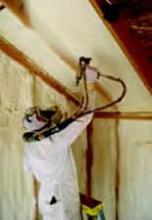Assessment and Prevention of Isocyanate Exposures in the Construction Industry (Completed – 2009-2014)
Carrie Redlich, MD, MPH
Yale University
New Haven, CT
Ph: 203-737-2817
[email protected]
Research Team
Small contractors, local unions, state health departments

“Going green” means construction workers are installing blown-in polyurethane foam insulation, which contains isocyanates – one of the most commonly reported causes of occupational asthma.
Spray-foam insulation holds considerable environmental promise. After applying a layer of the polyurethane product on roof decking and on the walls of a building, you can control the climate inside with a fraction of the energy you’d need otherwise. Homeowners looking to save on their utility bills have driven a rapid expansion in the spray-foam insulation market.
But how safe is it for the workers who apply it? Dr. Carrie Redlich examined this question – and found some concerning results.
First, there are hazardous substances involved. Polyurethane spray foams contain isocyanates, tertiary amine catalysts, blowing agents, and other chemicals. Isocyanates – potent sensitizers – are one of the leading causes of occupational asthma; amines can irritate mucous membranes and cause blurred vision.
In their study’s final year, Redlich’s team obtained further insight into isocyanate exposures in the construction industry and completed recruitment of study subjects. The resulting data showed bioactive exposures in a substantial proportion of spray foam workers, based on serum levels of the MDI (methylenediphenyl diisocyanate) exposure biomarker, and further documented a significant association between personal exposure estimates and biomarker levels. Subsequent data also showed a significant association between MDI exposure and work-related asthma symptoms.
Disseminating the findings from this study helped modify requirements for spray foam technical certification by a major world-wide trainer to include physical exams and education about isocyanate health effects, as part of a comprehensive medical clearance policy. Redlich’s team also completed and evaluated an MDI exposure-intervention program and began preparing the results for publication in the medical literature.
- There was an increase in awareness and attention to proper use of PPE by workers following surveillance
- Researchers gave talks and presentations to audiences at union halls, OSHA-sponsored and contractor events, and conferences.
- Researchers published an article in the journal Chemico-Biological Interactions.